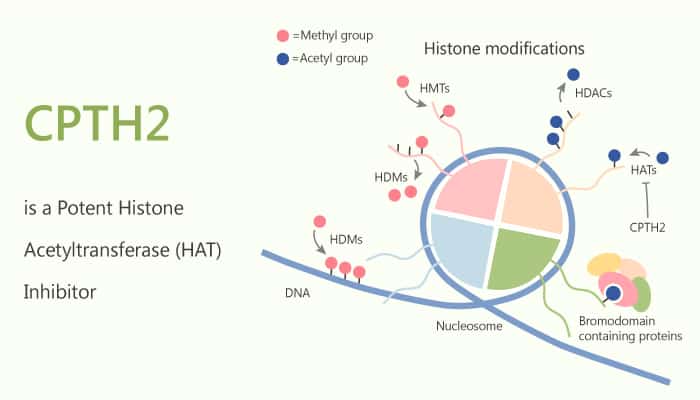Histone acetyltransferase (HATS) is an enzyme that acetylates the conserved lysine amino acids in histones by transferring acetyl from acetyl coenzyme A toε-N-acetyllysine. Several chromatin modifiers are responsible for adding different post-translational marks like acetylation, methylation, phosphorylation. Specifically, HATS add lysine at the N-terminal of acetyl histones H3 and H4 to specific groups. Besides, these characteristics increase the accessibility gene of basic chromatin or the wide area of the whole genome under specific conditions. Acetylation, therefore, determines a transcriptionally active state of the genome. For this reason, HATs are directly engaged in transcription as coactivators. The K-histone acetyltransferase KAT3B (p300) could play a role. In prostate cancer, KAT3B promotes tumor growth and activation of androgen receptor weakens invasiveness in melanoma, breast, and prostate cancer cell lines. CPTH2 is a potent histone acetyltransferase (HAT) inhibitor.

How does CPTH2 protect against cancer cells? Let’s discuss it in detail. In the beginning, CPTH2 selectively inhibits the acetylation of histone H3 by recombinant human Gcn5 in a substrate-competitive manner. In addition, CPTH2 decreases the invasiveness of a clear cell renal carcinoma (ccRCC) cell line through the inhibition of acetyltransferase p300 (KAT3B). Moreover, CPTH2 causes a decrease in cell proliferation after as early as 12 h with a further significant reduction after 48 h stimulation. Furthermore, CPTH2 causes a comparable drop in the activity in both cancer cell lines. CPTH2 produces a drastic increase in the apoptotic/dead cell population after 48 h. In vivo, it decreased acetylation of bulk histone H3 at the specific H3-AcK14 site. All in all, CPTH2 is a potent histone acetyltransferase (HAT) inhibitor.
References:
Chimenti F, et al. J Med Chem. 2009 Jan 22;52(2):530-6.